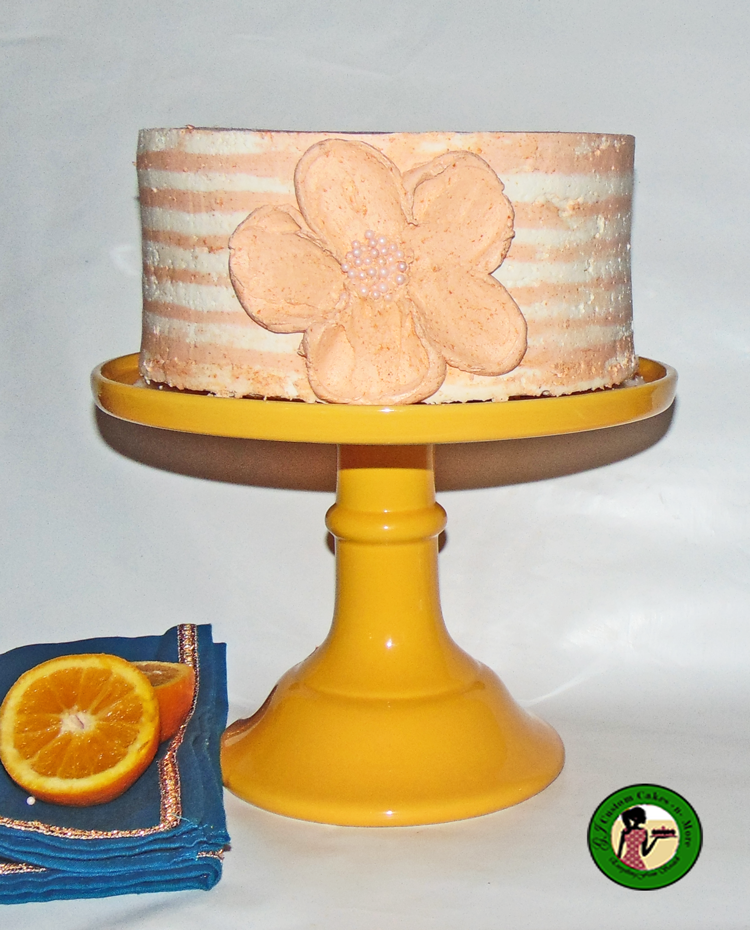Orange Chiffon Cake with Lemon Orange Italian Meringue Buttercream

Since I have opened my recipe test kitchen, I have been going strong testing new flavors. After all, change is good, especially when it is on the sweeter side of things. When I saw this Orange Chiffon Cake recipe in the southern living magazine, I knew I had to give it a try. My version, of course, is an Orange Chiffon Cake with Lemon Orange Italian Meringue Buttercream. Trust me; it tastes as good as it sounds. The flavor of the orange combined with the light texture of the cake is just enough flavor. Did I mention it is delicious?
Oranges bring back so much memory for me. Growing up, we lived in a town called Orangefield, and ironically my grandfather grew oranges. My siblings and I had so much fun tasting all the oranges. Even though it was a big farm, we knew what trees had the sweetest oranges. We made it our mission to know this. Oh, to be young again… This is one of the main reasons this Orange Chiffon Cake appealed to me so much.
This page may contain affiliate links which mean that if you purchase from any links directed from this website I may earn a small commission. I only recommend things that I use and love and the classes I have taken. Thank you very much for your ongoing support.
What is a Chiffon Cake?
A chiffon cake is a very light cake that gets this texture from the beaten egg whites. This is very similar to the actual chiffon fabric that is a light, silky, and smooth fabric. The process for making the Chiffon cake is straightforward. However, it is essential to use proper techniques. To make a chiffon cake, the egg yolks, oil, orange juice, and zest are added to the flour mixture. Egg whites are beaten to stiff peaks with cream of tartar. Cream of tartar is used to stabilize the egg whites so that they’re easier to whip up. The eggs whites in the cake make the cake rise and are folded into the mixture carefully.
Cake flour works best and gives a better result than all-purpose flour because of the lighter texture. Do not replace oil with butter in a chiffon cake because the oil is needed to provide the cake a softer texture. It is imperative to follow the recipe; we have a tendency to skim the page, and the recipe don’t do this. I am guilty too… I ended up tossing good yolks that needed to go into the batter. Of course, no big deal, I cracked some more eggs and was off to the races.
How to Make The Orange Chiffon Cake?
Traditionally chiffon cakes are baked in tube pans, but you can use regular cake pans as long as there is room for the cake to rise. I baked this orange chiffon cake twice and my second try, I halved the recipe and baked in an 8×3 cake pan, and the cake rose to the top, then added a glaze on top. I took the second version to work, and it was a big hit. 
Here are a few techniques that you can use to prevent bubbles, deflated cakes, or a dry cake. Fold the egg whites carefully and slowly do not deflate the egg whites. You can fold the egg whites into the batter with just the spatula. However, I suggest pouring the egg yolk mixture in the bowl with the egg white and use a balloon whisk to incorporate the egg whites. Let the cake cool in the pan upside down on a cooling rack to keep the height and from collapsing.
You don’t need to use buttercream; you can simply serve with an orange glaze. However, the lemon-orange Italian Meringue buttercream is such a great pairing with the orange chiffon cake. Double the recipe found here and
Why go through all this trouble? Because it is soooo good.

Orange Chiffon Cake with Lemon Orange Italian Meringue Buttercream
Ingredients
For the Cake
- 2 1/2 cup cake flour
- 1 1/2 cup granulated sugar
- 1 tbsp baking powder
- 1 tsp salt
- 1/2 cup vegetable oil
- 8 large eggs separate the eggs from the yolk
- 1/2 tsp cream of tartar
- 3/4 cup orange juice
- 3 tbsp orange zest from
Orange Glaze (optional)
- 1/2 small-medium Orange juiced
- 1 Cup powdered sugar
- 1 Tbsp orange zest
Lemon Orange Buttercream
- 1 1/2 tsp Lemon Zest
- 1 1/2 tsp orange zest
- 2 tbsp orange juice
- 2 tbsp Lemon Juice
- 8 large Egg whites
- 1 3/4 cups Sugar
- 1/2 cup water
- 4 sticks butter
Instructions
For the Cake
- Preheat the oven to 350F. Prepare 3 8-inch cake pans.
- Zest the orange and juice the oranges. Separate the egg whites from the yolk.

- Mix the flour, sugar, baking powder and salt together in a bowl.

- Mix the egg yolk, orange juice, zest, and vegetable oil together.
- Make a well in the center of the dry ingredients and add the wet ingredients.

- Add the cream of tartar to the egg whites and mix to stiff peaks.

- Pour the egg yolk and flour mixture to the meringue.

- Mix with a balloon whisk until combined

- Then use a spatula to finish mixing.

- Mix the batter while you turn the bowl.

- Pour the batter evenly into the three cake pans and bake for 25-30 minutes or until a toothpick comes out clean.
Glaze (optional)
- Mix the orange juice and zest with the powdered sugar. Add less orange juice if you want a thicker glaze. Add the glaze to the top of the cake.
Lemon Orange Italian Meringue Buttercream
- Add sugar and water to a medium saucepan with a candy thermometer. You are heating this mixture to a softball stage 235°F.
- In a mixing bowl add the egg whites (make sure the bowl is clean and dry). With the whisk attachment mix until the egg whites until it gets to stiff peak.
- When the hot sugar heats to 240°F, turn the mixer on high and slowly pour the hot syrup to the egg whites.
- Continue mixing until the bowl is cool to touch. Then add the butter one piece at a time. The mixture might look curdled at first, just keep on mixing. Mix until fully incorporated.
- Add the orange zest lemon juice and orange juice to the buttercream and mix until combined.









Erin | 27th Sep 19
The instructions are incomplete
G | 27th Sep 19
Sorry about that… I updated the recipe